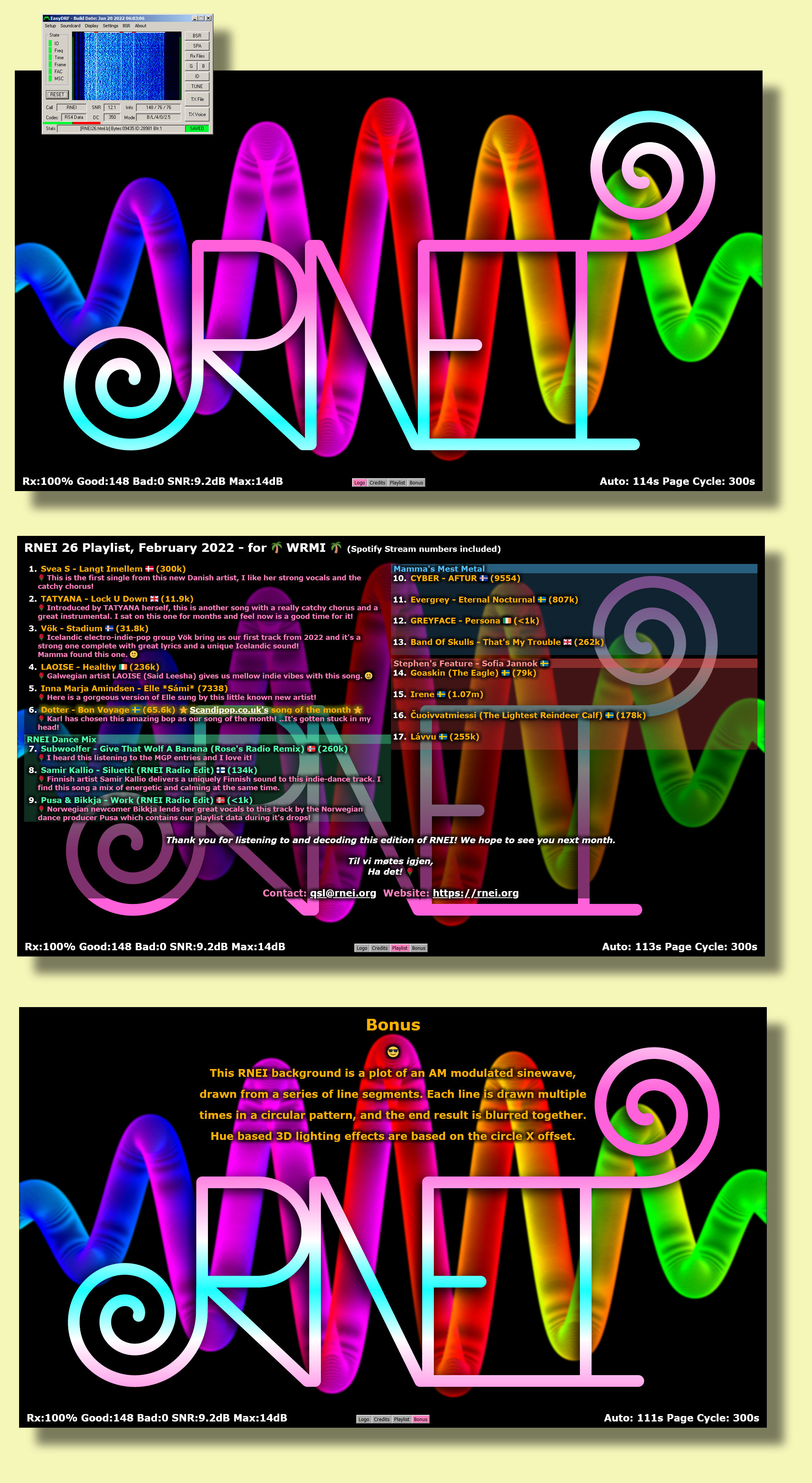http://www.rhci-online.net/radiogram/radiogram.htm
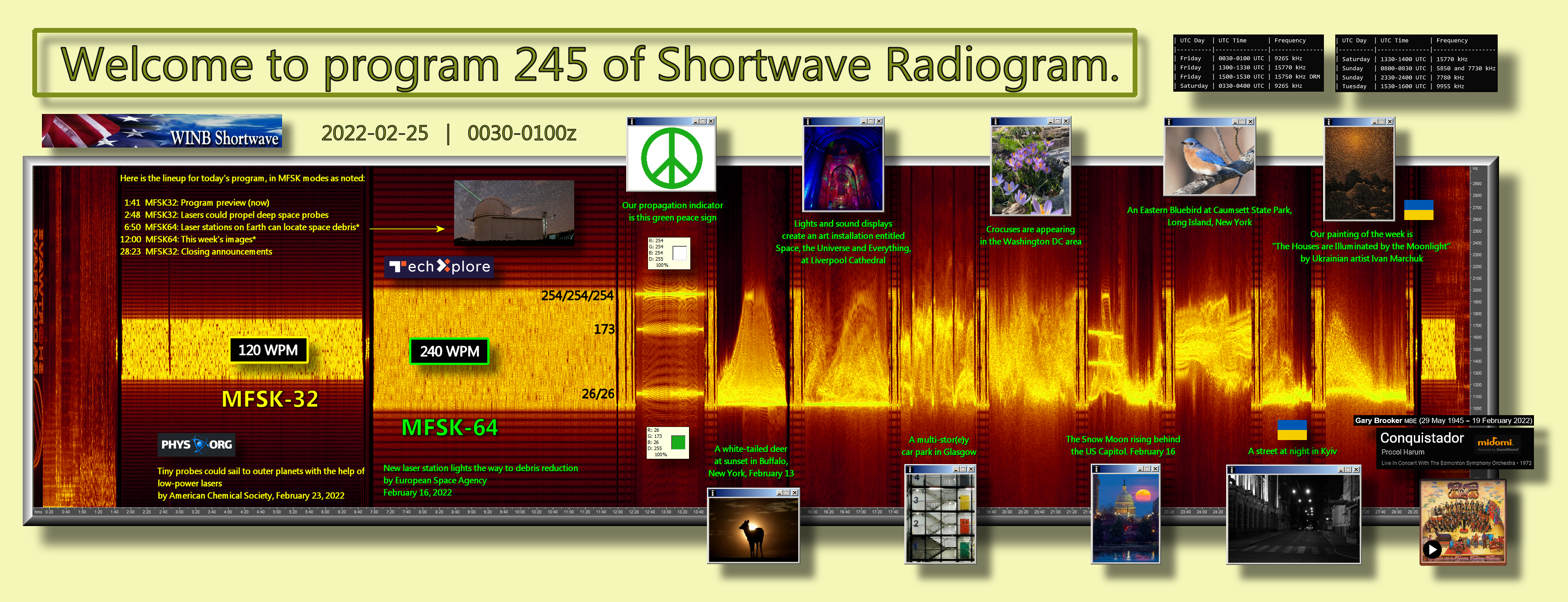
http://www.rhci-online.net/radiogram/radiogram.htm

RSID: <<2022-02-25T00:31Z MFSK-32 @ 9265000+1500>>
Welcome to program 245 of Shortwave Radiogram.
I'm Kim Andrew Elliott in Arlington, Virginia USA.
Here is the lineup for today's program, in MFSK modes as noted:
1:41 MFSK32: Program preview (now)
2:48 MFSK32: Lasers could propel deep space probes
6:50 MFSK64: Laser stations on Earth can locate space debris*
12:00 MFSK64: This week's images*
28:23 MFSK32: Closing announcements
* with image(s)
Please send reception reports to
radiogram@verizon.net
And visit http://swradiogram.net
We're on Twitter now: @SWRadiogram
From Phys.org:
February 23, 2022
Tiny probes could sail to outer planets with the help of
low-power lasers
by American Chemical Society
February 23, 2022
Space travel can be agonizingly slow: For example, the New
Horizons probe took almost 10 years to reach Pluto. Traveling to
Proxima Centauri b, the closest habitable planet to Earth, would
require thousands of years with even the biggest rockets. Now,
researchers calculate in ACS' Nano Letters that low-power lasers
on Earth could launch and maneuver small probes equipped with
silicon or boron nitride sails, propelling them to much faster
speeds than rocket engines.
Instead of catching wind, like the sails on boats, "laser sails"
would catch laser beams and could, in principle, push spacecraft
to nearly the speed of light. Scientists have been working on
this concept for a while. For example, one privately funded
project called the Breakthrough Starshot initiative aims to send
a small, sailed probe weighing about a gram to Proxima Centauri b
with a flight taking only 20 years. It would be propelled to 20%
of light speed by a 100 GW, kilometer-square laser array. Ho-Ting
Tung and Artur Davoyan wondered if much lower-power, smaller
laser arrays could find use in applications where conventional
electric and chemical rockets are now used. The lasers might
someday be able to adjust the orbit of satellites after launch or
propel tiny sailed probes on interplanetary or interstellar
missions, without requiring large amounts of fuel.
The researchers performed calculations to show that even lasers
with powers of about 100 kW and array sizes of about a meter
could power a 1-gram probe at velocities far exceeding the
current record, with only minutes to hours of laser illumination.
According to their calculations, the lasers could maneuver small
probes between different Earth orbits in only a day, which is not
possible with current electrical and chemical rockets. The team
determined that the best materials for the laser sails, which
allowed high reflectivity and rapid cooling, were silicon nitride
and boron nitride structured at the nanoscale. Finally, the
researchers calculated that these tiny laser-propelled probes
could travel fast enough to escape the solar system, reaching
five times higher velocities than the New Horizons probe. These
prototype sailed spacecraft, driven by low-power lasers, could
pave the wave for fast space exploration and future interstellar
flight, the researchers say.
https://phys.org/news/2022-02-tiny-probes-outer-planets-low-power.html
Shortwave Radiogram now changes to MFSK64 ...
RSID: <<2022-02-25T00:37Z
MFSK-64 @
9265000+1500>>
This is Shortwave Radiogram in MFSK64
Please send your reception report to
radiogram@verizon.net
From TechXplore:
New laser station lights the way to debris reduction
by European Space Agency
February 16, 2022
ESA's Izaña-1 laser ranging station in Tenerife, Spain, has
recently undergone months of testing and commissioning, passing
its final tests with flying colors. As it reached "station
acceptance," it was handed over to ESA from the German company
contracted to build it, DiGOS. The station is a technology
testbed and a vital first step in making debris mitigation widely
accessible to all space actors with a say in the future of our
space environment.
From satellite tracking to debris
Imagine lasers pointing from Earth into the skies, seeking out
satellites and bits of space trash and measuring their positions
and trajectories to prevent catastrophic collisions. You don't
have to try too hard—this is very nearly the day-to-day reality
at ESA's new Izaña 1 (IZN-1) laser ranging station in Tenerife,
Spain.
IZN-1, developed and now operated by ESA, is a testbed for future
technologies and was installed in mid-2021 at the Teide
Observatory. The station, telescope and laser have undergone
months of testing and commissioning and since July last year have
aimed the green beam of concentrated light to the sky to actively
detect, track and observe active satellites.
At present, the laser operates at 150mW but it will soon be
upgraded so it can also track debris objects with a much more
powerful infrared laser with an average power of 50 Watts.
"Currently, only satellites fitted with retroreflectors can be
tracked from ESA's Izaña station, making up just a proportion of
the total population," explains Clemens Heese, Head of Optical
Technologies.
"The station will be upgraded in the next couple of years,
enabling it to perform the same vital ranging services with
uncooperative targets—vitally, debris objects and older
satellites without retroreflecting patches."
The first of many in Europe
While dozens of laser tracking stations are dotted around Europe,
the Izaña station's dual functionality makes it a first. Built by
German company DiGOS, the remotely controlled Izaña station can
also be used for optical communications and is intended to become
a state-of-the-art, fully autonomous robotic system. It is hoped
to be the first of many across the globe.
Credit: European Space Agency
The technology, relatively new in the history of ground-based
observations of space debris, will mean the station can track
previously invisible defunct objects lurking above the blue
daytime skies.
As ESA's newest addition to the Space Safety family, Izana-1
provides support for vital collision avoidance and provides a
testbed for new sustainable technologies like laser momentum
transfer or coordination of space traffic.
Such satellite and debris tracking capability in Europe could
contribute to building and accessing a European catalog of space
objects.
Lasers in space. Is that … safe?
But hold on, there are birds, planes, astronauts above us!
Doesn't aiming lasers into the sky come with an unacceptable
risk? Fortunately, lasers used for satellite and debris tracking
would be a disappointment to any self-respecting Bond villain.
Ultimately, the IZN-1 station will use a power of under 100
Watts, giving the Izaña laser about 1/20th of the energy of an
electric kettle.
These pinpoint light sources shine short pulses of light at their
target, determining the distance, velocity and orbit of each one
with millimeter precision, calculated from the time it takes to
complete the return journey.
Although such lasers don't come anywhere close to cutting
through, or even nudging (yet) the objects they target, they can
damage sensitive optical instruments on satellites and the paths
of aircraft must be considered.
"If lasers strike planes they can be very dangerous, as pilots
can become distracted and in worst-case scenarios, lose control,"
explains Andrea di Mira, ESA Optoelectronics Engineer.
"We are very, very careful that this does not happen, with a set
of sensors scanning the sky for aircraft to ensure our lasers do
not get remotely close to them."
These lasers also have the potential to disrupt telescopes
studying the night's sky. To prevent this, the Laser Traffic
Control System (LTCS) was introduced by the Instituto de
Astrofísica de Canarias (IAC)—much like IZN-1 helps to prevent
collisions between objects in orbit, the LTCS software prevents
'collisions' between laser light and areas of observation.
Additionally, switching to an infrared laser frequency can
minimize conflicts with astronomers.
A vital step toward space traffic control
As the era of New Space is now fully underway, large
constellations are being launched to the skies consisting of
thousands, sometimes tens of thousands of satellites.
Current, costly methods of collision avoidance will be futile as
numbers increase and as such the international space community
will need to establish a method of space traffic control.
For this, precise and rapid determination of the location,
velocity and orbit of space objects will be vital, and ESA's
IZN-1 station will provide a much-needed testbed for this
technology, far more accurate than current radar methods, to be
developed.
Laser focus on the future
In the near future, ESA's IZN-1 station will be a fully
autonomous, highly productive satellite and debris tracking
station. It will also be used to test the concept of 'networked
space debris laser ranging' to build a satellite catalog.
When it comes to optical communication, it will also be upgraded
to receive signals with a very high data rate of 10 gigabits and
beyond (adhering to international standards) from satellites in
low-Earth orbit 400 km away.
Izaña will then become part of a planned European Optical Nucleus
Network, the first operational optical communication ground
station service of its kind that will be made available to the
wider commercial space community.
On top of all this, the station provides an opportunity to test
and develop technologies underpinning 'laser momentum transfer,"
in which lasers would not merely shine a light on debris objects
but very gently nudge them into new orbits, out of the way of
potential collisions and out of the busiest orbital highways.
As IZN-1 is welcomed into to ESA's Space Safety family, so is a
bright future of sustainable technologies, vital for a
responsible future in orbit and beyond.
https://techxplore.com/news/2022-02-laser-station-debris-reduction.html
This is Shortwave Radiogram in MFSK64
Please send your reception report to
radiogram@verizon.net
This week's images ...
Our propagation indicator is this green peace
sign.
https://etsy.me/3t22MbD ...
Sending Pic:197x145C;

A white-tailed deer at sunset in Buffalo, New York, February 13.
https://bit.ly/3t38QRg ...
Sending Pic:204x146C;

Lights and sound displays create an art installation entitled
Space, the Universe and Everything, at Liverpool Cathedral.
https://bit.ly/3HlQr73 ...
Sending Pic:179x192C;

A multi-stor(e)y car park in Glasgow.
https://bbc.in/3BOMvKU ...
Sending Pic:156x201C;

Crocuses are appearing in the Washington DC area.
https://bit.ly/3BMMV4E ...
Sending Pic:177x201C;
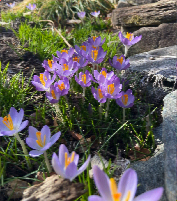
The Snow Moon rising behind the US Capitol. February 16.
https://bit.ly/3JPLVj8 ...
Sending Pic:151x202C;

An Eastern Bluebird at Caumsett State Park, Long Island, New
York. https://bit.ly/36EuKTl ...
Sending Pic:203x154C;

A street at night in Kyiv.
https://bit.ly/352Ew13 ...
Sending Pic:301x201;
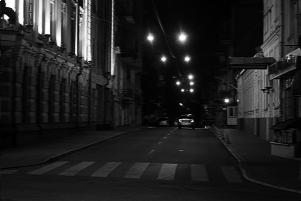
Our painting of the week is "The Houses are Illuminated by the
Moonlight" by Ukrainian artist Ivan Marchuk.
https://bit.ly/3veU4cz ...
Sending Pic:156x212C;

Shortwave Radiogram returns to MFSK32 ...
RSID: <<2022-02-25T00:58Z MFSK-32 @ 9265000+1500>>
This is Shortwave Radiogram in MFSK32 ...
Shortwave Radiogram is transmitted
by:
WRMI, Radio Miami International, wrmi.net
and
WINB Shortwave, winb.com
Please send reception reports to
radiogram@verizon.net
And visit http://swradiogram.net
Twitter:
@SWRadiogram or twitter.com/swradiogram
I'm Kim Elliott. Please join us for the next Shortwave
Radiogram.
|
Closing music SWRG#245:
https://www.midomi.com/Track?trackID
|

http://www.rhci-online.net/radiogram/radiogram.htm
|
QTH: |
D-06193 Petersberg (Germany/Germania) |
|
|
Ant.: |
Dipol for 40m-Band & Boomerang Antenna 11m-Band |
|
|
RX for RF: |
FRG-100B + IF-mixer & ICOM IC-R75 + IF-mixer |
|
|
Software IF: |
con STUDIO1 - Software italiano per SDR [S-AM-USB/LSB] + beta 11 Version 2.80 (August 21, 2018) - for scheduled IF-recording |
|
|
Software AF: |
Fldigi-4.0.18 + flmsg-4.0.7 images-fldigifiles on homedrive.lnk |
|
|
OS: |
German XP-SP3 with support for asian languages |
German W7 32bit + 64bit |
|
PC: |
MEDION Titanium 8008 (since 2003) [ P4 - 2,6 GHz] |
MSI-CR70-2MP345W7 (since2014) [i5 -P3560 ( 2 x 2,6GHz) ] |
http://wiki.radioreference.com/index.php/Decoding_the_SW_Radiogram_Broadcasts
https://www.qsl.net/ve7vv/Files/Digital%20Modes.pdf
RSID: <<2022-02-27T01:30Z
MFSK-64 @
5960000+1500>>
George Harrison was born February 25, 1943.
He died in 2001.
Sending Pic:238x178;
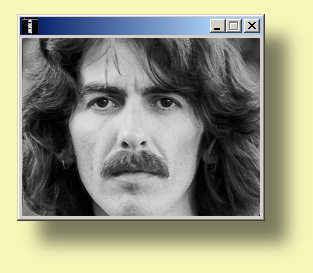
bit.ly/3JMliLT
Please report your decode to
themightykbc@gmail.com

RSID: <<2022-02-24T13:53Z MFSK-64 @ 15770000+1500>>

This Is An Express Music Show
February 2022
Channel 292 on 6070 kHz
----------------------------------------
PLAYLIST
The Majestics - Tighten Up
------
Della Reese - It Was A Very Good Year
Ronnie Fostter - Love Satellite
The Romeos - Eyes Of Pearl
Wayne Wade - No Two
Hell And Fire - Show Us The Way
------
THIS DATA - Bert Kaempfert - Mason Dixon Line
------
Tyrone Davis - I Keep Coming Back
----------------------------------------
Please send reception reports/comments:
thisisamusicshow@gmail.com
Follow TIAMS on Twitter:
www.twitter.com/ThisIsAMusicSho/
**WEBSITE**
https://thisisamusicshow.com
------
Thanks for listening!
--YOUR HOST--
EOM
RSID: <<2022-02-24T13:55Z
MFSK-64 @
15770000+1500>>
Sending Pic:300x300Cp2;

RSID: <<2022-02-24T02:51Z MFSK-64 @ 5850000+1500>>
This Is A Music Show #154
24 February 2022
0200-0300UTC Thursday on 5850 kHz
via WRMI, Okeechobee USA
***ALSO***
TIAnExpressMS w/ Radio Northern Europe International
via Channel 292 in Germany, mainly on 6070 kHz.
Broadcast various dates/times/freqs. Check the schedule here:
https://www.channel292.de/
https://rnei.org/
----------------------------------------
PLAYLIST
Lito Peña And His Orchestra Panamerica - Yo Vivo Enamorado
-----
Sonny Phillips - Black On Black
James Brown - Popcorn With A Feeling
Brook Benton - Born Under A Bad Sign
-----
Au Pairs - America
Malo - Latin Bugaloo (Edit)
Talbot Brothers Of Bermuda - Gonna Cut You With The Razor
-----
Phono-Comb - The Lyon Game
The Unintended - The Light
-----
Ken Booth - I'm Going Home VERSION
Clinch All Stars - Thunder Storm Part 2 Mix
-----
Jean-Jacques Perrey And Harry Breuer - March Of The Martians
-----
THIS DATA w/ Bert Kaempfert - Arizona Flip
-----
Patrician Anne - Long Long Time
----------------------------------------
TIAMS Website:
https://thisisamusicshow.com
Go here for show archives + official shop!
-----
Please send reception reports/comments:
thisisamusicshow@gmail.com
Follow TIAMS on Twitter:
www.twitter.com/ThisIsAMusicSho/
------
Thanks for listening!
--YOUR HOST--
EOM
RSID: <<2022-02-24T02:53Z
MFSK-64 @
5850000+1500>>
Sending Pic:300x300Cp4;
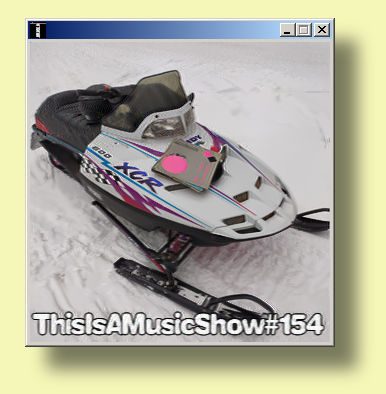
|
- |
|
RNEI 26 Playlist, February 2022 - for 🌴 WRMI 🌴 (Spotify Stream numbers included) |
||||||
|
|
|
|
|
YT date |
|
|
|
1 |
Svea S - Langt Imellem |
🇩🇰 |
(300k) |
https://www.midomi.com/Track?trackID=100441423238720745&song=langt-imellem |
2021-09-23 |
|
|
2 |
TATYANA - Lock U Down |
🇬🇧 |
(11.9k) |
https://www.midomi.com/Track?trackID=100766660472843796&song=lock-u-down |
2022-02-01 |
|
|
3 |
Vök - Stadium |
🇮🇸 |
(31.8k) |
https://www.midomi.com/Track?trackID=100286606756504625&song=stadium |
2022-01-06 |
|
|
4 |
LAOISE - Healthy |
🇮🇪 |
(236k) |
https://www.midomi.com/Track?trackID=100255700051318854&song=healthy |
2020-10-23 |
|
|
5 |
Inna Marja Amindsen - Elle |
*Sámi* |
(7338) |
- - - |
2021-04-22 |
|
|
6 |
Dotter - Bon Voyage |
🇸🇪 |
(65.6k) |
https://www.midomi.com/Track?trackID=100351635596249253&song=bon-voyage |
2022-01-21 |
|
| RNEI Dance Mix: | ||||||
|
7 |
Subwoolfer - Give That Wolf A Banana (Rose's Radio Remix) |
🇳🇴 |
(260k) |
https://www.midomi.com/Track?trackID=100942089219577610&song=give-that-wolf-a-banana |
2022-01-10 |
|
|
8 |
Samir Kallio - Siluetit (RNEI Radio Edit) |
🇫🇮 |
(134k) |
- - - |
2021-09-04 |
|
|
9 |
Pusa & Bikkja - Work (RNEI Radio Edit) |
🇳🇴 |
(<1k) |
- - - |
2022-01-06 |
|
|
|
Mamma's Mest Metal |
|
|
|
||
|
10 |
CYBER - AFTUR |
🇮🇸 |
(9554) |
https://www.midomi.com/Track?trackID=100006745888851583&song=aftur JÓHANNA RAKEL JÓNASDÓTTIR https://open.spotify.com/track/32fEGUk9J6pJFwxdUmhkMe?si=382cfb7f0c2b491c |
2018-11-17 |
|
|
11 |
Evergrey - Eternal Nocturnal |
🇸🇪 |
(807k) |
- - - |
2021-01-08 |
|
|
12 |
GREYFACE - Persona |
🇮🇪 |
(<1k) |
- - - |
2021-10-28 |
|
|
13 |
Band Of Skulls - That's My Trouble |
🇬🇧 |
(262k) |
https://www.midomi.com/Track?trackID=100575565800070763&song=that%27s-my-trouble |
2019-07-01 |
|
| Stephen's Feature - Sofia Jannok | 🇸🇪 | |||||
|
14 |
Goaskin (The Eagle) |
🇸🇪 |
(79k) |
https://www.midomi.com/Track?trackID=100065829108003527&song=goaskin-(the-eagle) |
2019-01-13 |
|
|
15 |
Irene |
🇸🇪 |
(1.07m) |
- - - |
2013-01-25 |
|
|
16 |
Čuoivvatmiessi (The Lightest Reindeer Calf) |
🇸🇪 |
(178k) |
2019-01-13 |
||
|
17 |
Lávvu |
🇸🇪 |
(255k) |
- - - |
2020-12-31 |
|
http://www.rhci-online.net/html/RNEI26.html
http://www.rhci-online.net/html/RNEI26-ch292.html
